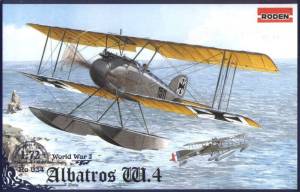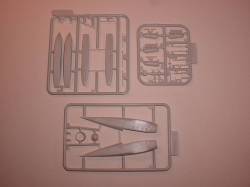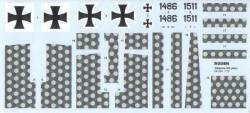| Roden 1/72nd Albatros W.4 (Early) |  | History In 1916, the German high command placed an order with several companies for the creation of a fighter with floats. Its primary use was to be defense of the coast of Flanders. Albatros quickly took its D.I and redesigned it to meet this need. While the fuselage remained the same, the wing area – as well as the gap between the wings – increased. The tail changed as did the fuselage underside to accept the floats. The first three off the assembly line – which could probably be considered prototypes – had the small floats of the early W.4. This led to a number of pilot complaints, resulting in the redesign of the floats. These later, longer floats were added to the rest of the production run. The Roden W.4 (Early) was already reviewed in the January 2003 IM. The Kit  The Roden W.4 (Late) is molded up to Roden's usual standards – with a couple of caveats. The kit comes with 58 parts on the sprue, of which 12 aren't used for the Late version. Decals are for the first two of the later run series - No. 1486 and No.1511. Decals consist of crosses for the wings, fuselage and rudder, as well as the above mentioned numerals and the Axial logos for the props and a couple of small decals meant – it looks like – for the datum panels. Also included with the Late release is a set of lozenge for those areas requiring it. It appears that the colors are close - not perfect, but close. One item to mention. Even though there are numerals to make 1511, there are no instructions for that machine. Instead one has to rely (if you don't have references) on the box top. The Roden W.4 (Late) is molded up to Roden's usual standards – with a couple of caveats. The kit comes with 58 parts on the sprue, of which 12 aren't used for the Late version. Decals are for the first two of the later run series - No. 1486 and No.1511. Decals consist of crosses for the wings, fuselage and rudder, as well as the above mentioned numerals and the Axial logos for the props and a couple of small decals meant – it looks like – for the datum panels. Also included with the Late release is a set of lozenge for those areas requiring it. It appears that the colors are close - not perfect, but close. One item to mention. Even though there are numerals to make 1511, there are no instructions for that machine. Instead one has to rely (if you don't have references) on the box top. Construction starts with the eight pieces of the engine, paying attention to the instructions telling you what to remove for this version of the W.4. From there construction moves to parts of the cockpit, to adding these and other parts – as well as the engine - into one fuselage half and assembling the fuselage halves. Again, the instructions need to be followed closely as they tell you which external details need to be removed from the fuselage halves for this version.  Once the fuselage halves are assembled, then construction moves to adding the tail, lower wings and the forward, upper part of the fuselage. In all reviews I have read on Roden's Albatros', dry fitting is a must when adding the forward, upper fuselage to achieve a close-to-perfect fit. In addition part of the nose, behind the spinner, is added at this time. Once the fuselage halves are assembled, then construction moves to adding the tail, lower wings and the forward, upper part of the fuselage. In all reviews I have read on Roden's Albatros', dry fitting is a must when adding the forward, upper fuselage to achieve a close-to-perfect fit. In addition part of the nose, behind the spinner, is added at this time. Now the floats are glued together. Care must be taken when removing the upper parts of the floats as the struts that connect the two floats together horizontally are molded integral with the upper float pieces. The last part of major construction – before putting all the pieces together to make up a complete airframe – is the gluing together of the three, upper wing parts. Again, care and dry fitting are the norm to achieve a close-to-perfect fit. Since all of the major parts of the plane are now together, construction moves to adding the upper wing, floats and all struts associated with both. However, before doing so I recommend painting each part individually first.  The later series appeared to be not only covered in lozenge on some surfaces, but the fuselage was painted - unlike the Early series that left the fuselage (and fabric) areas in their natural color.. The later series appeared to be not only covered in lozenge on some surfaces, but the fuselage was painted - unlike the Early series that left the fuselage (and fabric) areas in their natural color.. Conclusion This is another, decent Roden Albatros. With much care and patience a very handsome floatplane will be the result. Definitely recommonded. Our thanks to Roden and Squadron for the review kits. | 







|

 The Roden W.4 (Late) is molded up to Roden's usual standards – with a couple of caveats. The kit comes with 58 parts on the sprue, of which 12 aren't used for the Late version. Decals are for the first two of the later run series - No. 1486 and No.1511. Decals consist of crosses for the wings, fuselage and rudder, as well as the above mentioned numerals and the Axial logos for the props and a couple of small decals meant – it looks like – for the datum panels. Also included with the Late release is a set of lozenge for those areas requiring it. It appears that the colors are close - not perfect, but close. One item to mention. Even though there are numerals to make 1511, there are no instructions for that machine. Instead one has to rely (if you don't have references) on the box top.
The Roden W.4 (Late) is molded up to Roden's usual standards – with a couple of caveats. The kit comes with 58 parts on the sprue, of which 12 aren't used for the Late version. Decals are for the first two of the later run series - No. 1486 and No.1511. Decals consist of crosses for the wings, fuselage and rudder, as well as the above mentioned numerals and the Axial logos for the props and a couple of small decals meant – it looks like – for the datum panels. Also included with the Late release is a set of lozenge for those areas requiring it. It appears that the colors are close - not perfect, but close. One item to mention. Even though there are numerals to make 1511, there are no instructions for that machine. Instead one has to rely (if you don't have references) on the box top. Once the fuselage halves are assembled, then construction moves to adding the tail, lower wings and the forward, upper part of the fuselage. In all reviews I have read on Roden's Albatros', dry fitting is a must when adding the forward, upper fuselage to achieve a close-to-perfect fit. In addition part of the nose, behind the spinner, is added at this time.
Once the fuselage halves are assembled, then construction moves to adding the tail, lower wings and the forward, upper part of the fuselage. In all reviews I have read on Roden's Albatros', dry fitting is a must when adding the forward, upper fuselage to achieve a close-to-perfect fit. In addition part of the nose, behind the spinner, is added at this time. The later series appeared to be not only covered in lozenge on some surfaces, but the fuselage was painted - unlike the Early series that left the fuselage (and fabric) areas in their natural color..
The later series appeared to be not only covered in lozenge on some surfaces, but the fuselage was painted - unlike the Early series that left the fuselage (and fabric) areas in their natural color.. 






